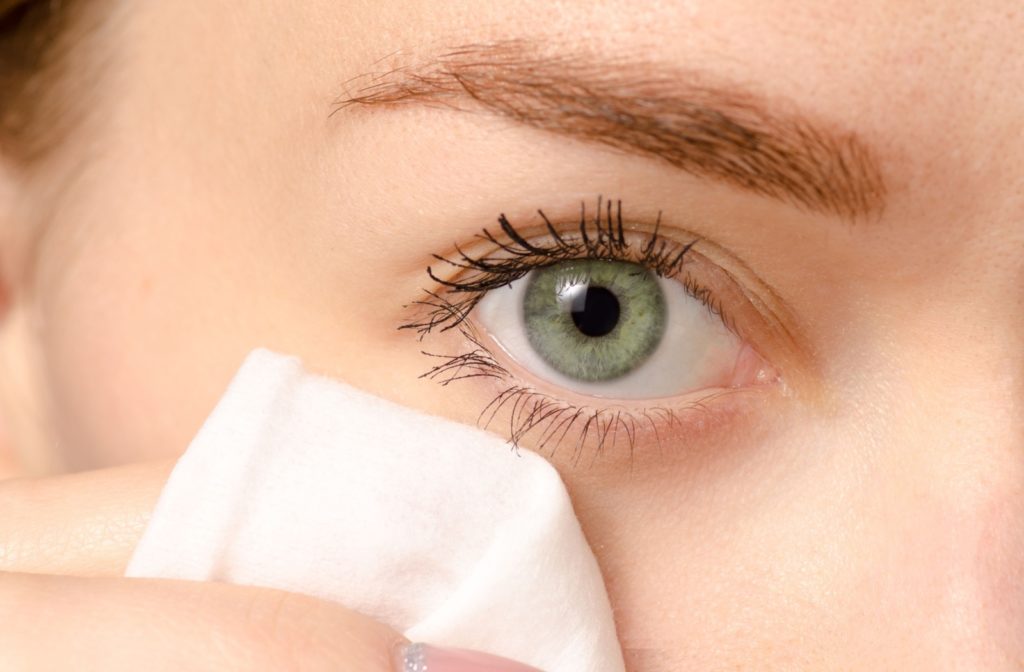Meibomian gland blockage or dysfunction is the leading cause of dry eyes. When the meibomian or oil glands in the eyes become blocked, it affects tear quality, leading to mild or significant eye and vision discomfort.
But don’t worry—there are effective ways to treat and manage this eye condition, such as:
- Eye drops
- Heated masks
- Lid hygiene
- Punctal plugs
- Meibomian gland expression
Your eye doctor can perform a comprehensive eye exam to diagnose meibomian gland dysfunction and recommend the right and most effective treatment for symptom relief.
What Is Meibomian Gland Dysfunction?
Your meibomian glands are small oil-producing glands that are found along the edges of your eyelids. These glands play a critical role in maintaining your eye’s tear film by releasing oils that keep the surface of your eyes moist. When these glands become blocked or stop working properly, it leads to meibomian gland dysfunction (MGD).
Tears consist of water, oil, and mucus. Without the protective oils, your tears evaporate more quickly, leaving your eyes dry, irritated, and inflamed. Here are some of the most common symptoms of MGD to watch for:
- Dryness
- Redness
- Grittiness or scratchiness
- Blurred vision
- Sensitivity to light
- Burning or stinging sensation
- Excess tearing
Risk Factors for Meibomian Gland Blockage
While anyone can develop meibomian gland blockage, some factors may increase your risk of developing the condition. These can include:
- Age: As we age our meibomian glands may become less efficient at producing oils, increasing the risk for blockages.
- Certain medical conditions: Conditions such as rosacea or blepharitis can affect the function of your meibomian glands.
- Makeup: Females are more prone to MGD due to makeup use.
- Contact lenses: Contact lens wear can cause meibomian gland changes that worsen MGD.
Why Early Detection of MGD is Important
Like many eye conditions and diseases, early detection and treatment of MGD is vital. Untreated MGD can worsen over time, potentially leading to more severe complications such as chronic dry eye disease and damage to the surface of your cornea (the clear front surface of the eye). The sooner you address the issue, the quicker you can improve your symptoms, prevent future problems, and restore vision and comfort to your everyday life.
Diagnosing meibomian gland blockage is typically done through a comprehensive eye exam performed by your eye doctor. During the eye exam, they will evaluate your symptoms and use specialized tools to examine the glands along your eyelids. They may apply pressure to determine if the glands are functioning properly or use a dye solution to check for blockages.
A test to check tear film stability and tear quality includes the tear breakup time (TBUT) test. This test uses a dye that helps check how quickly the tears break up and how fast they evaporate from the eyes.

Meibomian Gland Blockage Treatment
Several treatment strategies can relieve MGD symptoms and support your eye health.
Eye Drops
In severe cases, your eye doctor may recommend prescription medications, such as eye drops or ointment, to control inflammation.
Heated Masks
Professional heated masks can provide consistent heat to your eyelids, improving the oil flow from your glands. Warm compresses placed over the eyelids can also help loosen blockages in your meibomian glands, making it easier for the oils to flow.
Lid Hygiene
Cleaning your eyelids gently with a lid-cleaning wipe or a mild cleanser recommended by your optometrist can reduce the amount of bacteria and debris on your eyelids that clog your glands.
Punctal Plugs
Punctal plugs are small inserts placed in the tear ducts to prevent tears from draining too fast and can provide some dry eye relief caused by MGD.
Meibomian Gland Expression
Meibomian gland expression is a manual technique performed by your eye doctor to unclog your meibomian glands. This treatment may provide significant symptom relief.
How to Prevent Meibomian Gland Blockage
Taking a few proactive steps can prevent future blockages and keep your eyes comfortable and healthy:
- Schedule regular eye exams to monitor your eye health.
- Hydrate by drinking water.
- Take frequent breaks during prolonged screen time.
- Follow a daily lid hygiene routine recommended by your eye doctor.
- Avoid smoking.
- Blink fully and regularly to stimulate tear production.
- Avoid using makeup or products that may block the glands.
- Use a humidifier to keep the air moist.
- Wear sunglasses to protect your eyes from sun, smoke, and wind.
When to Seek Professional Help
If you’re dealing with any symptoms of MGD, don’t wait, as your comfort and vision can worsen. Without treatment, you can risk developing an eyelid infection or a meibomian cyst (a painful bump on the eyelid).
Vision Comfort with Personalized Treatment
While MGD can be uncomfortable and affect your vision quality and quality of life, treatment options can provide relief. With professional care, at-home strategies, and a few lifestyle adjustments, you can manage MGD symptoms and protect your eye health long-term.
If you experience dry eye symptoms or vision changes, book an appointment with Rancho Santa Margarita Optometry for personalized treatment, meaningful relief, and vision comfort.


